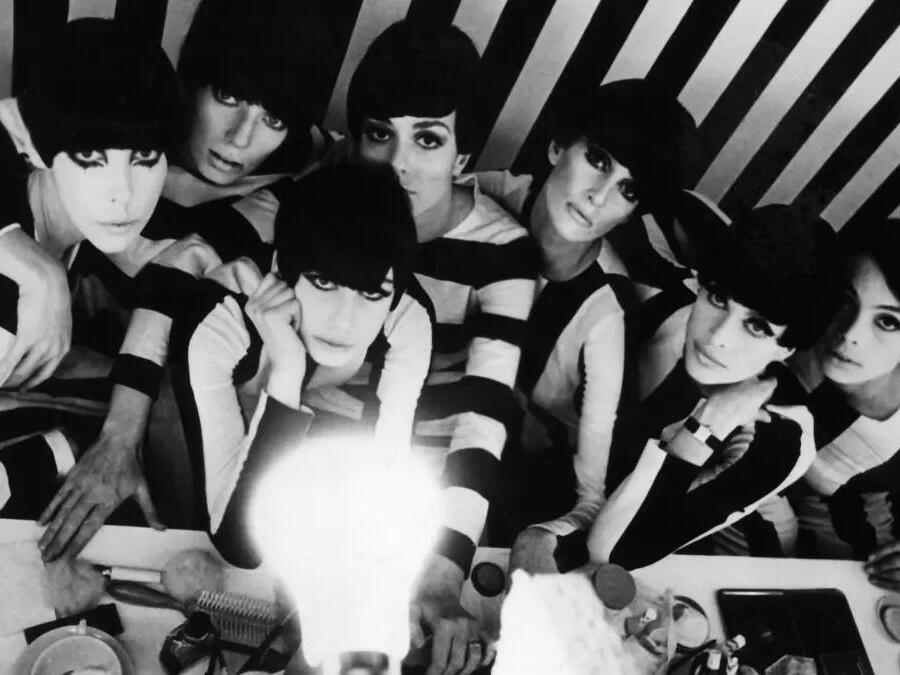Physical Address
304 North Cardinal St.
Dorchester Center, MA 02124
Physical Address
304 North Cardinal St.
Dorchester Center, MA 02124

Peggy Moffitt, the iconic fashion model who brought a distinct edge to 1960s fashion with her unique makeup and mime-inspired poses, passed away at her Beverly Hills home at the age of 86.
Moffitt seemed to embody timeless fashion. Her son, Christopher Claxton, informed the New York Times that she died on Saturday due to complications from dementia.
Moffitt was best known as the muse of avant-garde designer Rudi Gernreich. Her striking appearance—including a mask-like white complexion, elongated black lashes, vividly colored eye shadows, and occasionally adorned cheeks with daisies, teardrops, or silver triangles—helped convey the futuristic themes of Gernreich’s collections.
Her short, geometric haircut, styled by Vidal Sassoon, further accentuated her signature look, making her a fashion icon of the ’60s. Even after her modeling career ended, she retained this stylized appearance.
In 1964, Moffitt caused a fashion uproar by posing in a topless swimsuit designed by Gernreich. Modeled after schoolboy shorts with suspenders rising between the cleavage, the suit faced global condemnation from the Vatican, the Kremlin, and several governments.
“I agreed to do it only when I finally believed that Rudi wasn’t exploiting me,” Moffitt revealed. “There really was a message, and that message was ‘freedom.’”
Moffitt posed with a shy schoolgirl demeanor in front of the camera as her husband, renowned commercial photographer William Claxton, captured the moment in their living room. Requested by several magazines to take a less revealing shot, Claxton took an additional photograph from the back. The images were then featured in newspapers and magazines worldwide.
In 1965, Moffitt posed in another bold Gernreich creation—a sheer “no-bra” that defied the structured lingerie of the 1950s.
“In those days, if a model was photographed in lingerie, that was it, she was definitely B-team,” Moffitt recalled in a 1992 interview with the London Independent newspaper.
Hired to photograph her for Vogue, top photographer Richard Avedon captured Moffitt’s image. “My teenage dream was to have a swimming pool and to work with Avedon every day,” she confessed later.
During Gernreich’s meteoric rise in the fashion world, Moffitt remained his free-spirited companion.
“Peggy Moffitt was the epitome of the muse,” said Patty Fox, former fashion director for Saks Fifth Avenue. Fox emphasized that unlike classical supermodels, Moffitt created and maintained a distinctive, somewhat artificial look, pushing the boundaries of fashion.
Moffitt’s unique style left strong impressions.
“I was told I couldn’t model by every tacky editor and photographer in the world,” Moffitt shared with author Joel Lobenthal in his book “Radical Rags: Fashions of the Sixties.” She aimed to create a new way of modeling that elevated it into an art form.
In meticulously planned fashion shows, Moffitt transformed her attire to evoke various characters, such as a “Japanese school girl” or a “Chinese opera star.”
“I entertained myself and the audience by regarding the collection as a play, with each outfit a new act or a new character,” she wrote in “The Rudi Gernreich Book,” a 1991 collaboration with Claxton. Instead of merely modeling clothes, she performed them.
By the mid-1960s, her face had become synonymous with Gernreich’s fashions. ”We were like Tweedledum and Tweedledee, Gilbert and Sullivan, ham and eggs,” she said. They understood each other’s ideas instinctively, functioning as a singular entity.
Born in Los Angeles in 1937 as the only child of film reviewer and writer Jack Moffitt, Peggy attributed her interest in extreme fashion and makeup to her high school years at Marlborough School, where uniforms and lipstick were strictly forbidden.
At 17, Moffitt worked at Jax, a Rodeo Drive boutique showcasing designer brands, including Gernreich’s. Initially, she aspired to be an actress, studying at the Neighborhood Playhouse in New York City. She landed small roles in movies like “You’re Never Too Young” and “The Birds and the Bees.”
Moffitt met Claxton during one of his photography assignments. They became engaged and married within the year.
Gernreich, Moffitt, and Claxton collaborated to create iconic fashion photographs. One such image showed Moffitt in a knit swimsuit, accessorized with a fencer’s visor and tall boots.
Always seeking new ways to blend fashion and theater, Moffitt once ended a fashion show by playing mad Ophelia from Shakespeare’s “Hamlet,” showcasing her theatrical flair.
London’s supermodel Twiggy credited Moffitt for teaching her that modeling was more than just about having a pretty face. “She consciously controlled the sort of shape she presented to the camera,” Twiggy wrote in her autobiography.
Despite her close association with Gernreich, Moffitt noted that their collaboration had its drawbacks. “People thought we were joined at the hip,” she told the Independent in 1992.
In the mid-1960s, Moffitt and Claxton spent more time in Europe for his assignments. She also appeared in the classic 1966 film “Blow Up.”
Returning to Los Angeles in the early 1970s, the couple had their only child, Christopher. Claxton passed away in 2008. Moffitt is survived by her son.
Moffitt continued working with Gernreich until his death in 1985, after which she left the fashion industry.
Moffitt owned over 300 Gernreich pieces, some of which were featured in a 2012 exhibit at the Museum of Contemporary Art at the Pacific Design Center. She retained the legal rights to all of Gernreich’s creations and hoped to relaunch his brand.
“That I am still wearing his clothes 50 years later is as good a recommendation for someone’s talent as any,” she told The Times in 2013. “The times have changed, but his clothes still hold up for the way we live today.”
Source: Los Angeles Times



